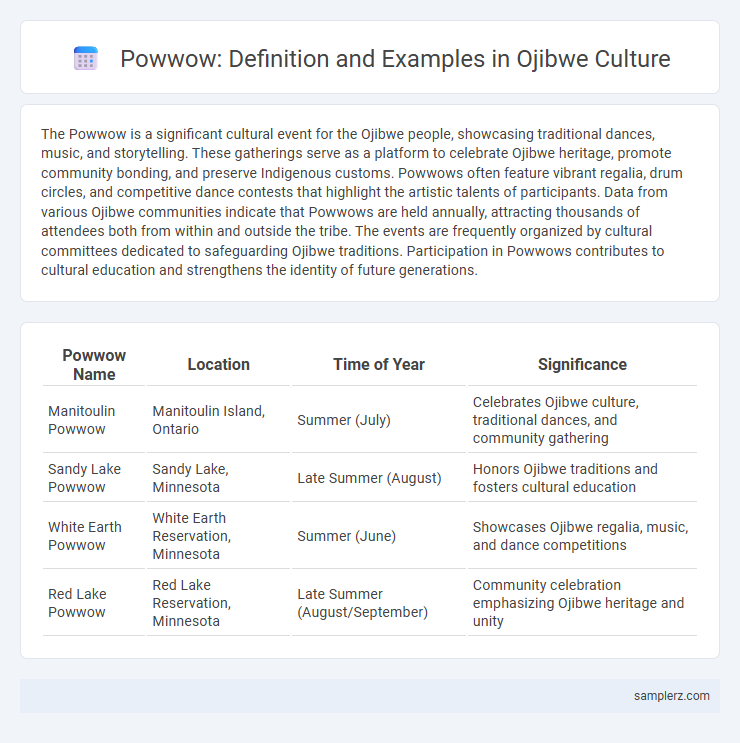The Powwow is a significant cultural event for the Ojibwe people, showcasing traditional dances, music, and storytelling. These gatherings serve as a platform to celebrate Ojibwe heritage, promote community bonding, and preserve Indigenous customs. Powwows often feature vibrant regalia, drum circles, and competitive dance contests that highlight the artistic talents of participants. Data from various Ojibwe communities indicate that Powwows are held annually, attracting thousands of attendees both from within and outside the tribe. The events are frequently organized by cultural committees dedicated to safeguarding Ojibwe traditions. Participation in Powwows contributes to cultural education and strengthens the identity of future generations.
Table of Comparison
| Powwow Name | Location | Time of Year | Significance |
|---|---|---|---|
| Manitoulin Powwow | Manitoulin Island, Ontario | Summer (July) | Celebrates Ojibwe culture, traditional dances, and community gathering |
| Sandy Lake Powwow | Sandy Lake, Minnesota | Late Summer (August) | Honors Ojibwe traditions and fosters cultural education |
| White Earth Powwow | White Earth Reservation, Minnesota | Summer (June) | Showcases Ojibwe regalia, music, and dance competitions |
| Red Lake Powwow | Red Lake Reservation, Minnesota | Late Summer (August/September) | Community celebration emphasizing Ojibwe heritage and unity |
Introduction to Powwows in Ojibwe Culture
Powwows in Ojibwe culture serve as vibrant gatherings that celebrate indigenous heritage through traditional dance, music, and storytelling. These events foster community cohesion and cultural continuity by honoring ancestral customs and spiritual beliefs. Central to the powwow are drum circles and regalia, which symbolize Ojibwe identity and the enduring connection to their land and history.
Historical Roots of Ojibwe Powwows
Ojibwe powwows trace their historical roots to seasonal gatherings that celebrated community unity, spiritual ceremonies, and the harvest cycle. These events served as vital platforms for preserving oral traditions, storytelling, and honoring ancestors through dance and song. Rooted in centuries-old Anishinaabe customs, Ojibwe powwows reflect resilience and cultural revitalization despite colonial pressures.
Key Elements of an Ojibwe Powwow
An Ojibwe powwow features vibrant traditional dance styles such as the Fancy Dance, Grass Dance, and Jingle Dress Dance, each symbolizing cultural stories and spiritual beliefs. Key elements include the honor beats from the drum circle, the ceremonial grand entry of dancers, and the use of regalia adorned with beadwork, feathers, and quills that reflect individual and community identities. The powwow serves as a powerful gathering for socializing, storytelling, and preserving Ojibwe language and traditions through songs and rituals.
Traditional Dance Forms at Ojibwe Powwows
Ojibwe powwows showcase vibrant traditional dance forms such as the Fancy Dance, Jingle Dress Dance, and Grass Dance, each symbolizing unique cultural stories and spiritual significance. The Jingle Dress Dance is particularly revered for its healing powers and is performed by women adorned with metal cones that create rhythmic sounds. These dances preserve Ojibwe heritage, reinforcing communal bonds and passing down ancestral knowledge through generations.
Powwow Regalia and Its Cultural Significance
Powwow regalia in Ojibwe culture is a vibrant and deeply symbolic expression of identity, history, and spirituality, featuring intricately beaded moccasins, feathered headdresses, and colorful shawls. Each element of the regalia carries specific meanings, such as honoring ancestors, showcasing clan affiliations, and representing personal achievements. The craftsmanship and materials used in these garments highlight traditional techniques passed down through generations, reinforcing cultural continuity and pride within the Ojibwe community.
Role of Drumming and Singing in Ojibwe Gatherings
Drumming and singing are central to Ojibwe powwows, serving as spiritual and cultural expressions that unite participants and honor ancestral traditions. The heartbeat-like rhythm of the drum symbolizes the pulse of Mother Earth, while songs convey stories, teachings, and communal values integral to Ojibwe identity. These musical elements facilitate connection, healing, and the passing down of heritage within the community.
Spiritual Practices at Ojibwe Powwows
Ojibwe powwows serve as vibrant gatherings where spiritual practices, such as the Grand Entry and honoring of veterans, anchor the community's connection to their heritage and ancestors. The use of sacred songs, drumming, and smudging ceremonies facilitates purification and spiritual renewal, reinforcing Ojibwe identity. These rituals at powwows foster a deep respect for nature and the Creator, emphasizing balance and harmony within the cultural framework.
Community and Social Functions of Powwows
Ojibwe powwows serve as vital community gatherings that strengthen social bonds and cultural identity through shared dance, music, and storytelling. These events foster intergenerational connections, allowing Elders to pass down traditions and language to younger members. Powwows also provide a platform for communal celebration, unity, and the reaffirmation of Ojibwe values and spirituality.
Notable Ojibwe Powwows: Celebrated Events
Notable Ojibwe powwows such as the Mille Lacs Band Powwow in Minnesota and the White Earth Powwow showcase vibrant traditional dances, drumming, and singing, attracting thousands of attendees annually. These celebrated events highlight the Ojibwe's rich cultural heritage and serve as important gatherings for community bonding and cultural preservation. Each powwow features Grand Entry ceremonies, intertribal dances, and contests that honor Ojibwe history and spirituality.
Preserving Ojibwe Heritage Through Powwows
Powwows play a vital role in preserving Ojibwe heritage by fostering cultural continuity through traditional dances, drumming, and storytelling. These gatherings provide opportunities for intergenerational knowledge transfer, strengthening language use and spiritual practices rooted in Ojibwe identity. The communal nature of powwows ensures that rituals, art, and values remain vibrant within Ojibwe communities across North America.

example of powwow in Ojibwe Infographic
 samplerz.com
samplerz.com